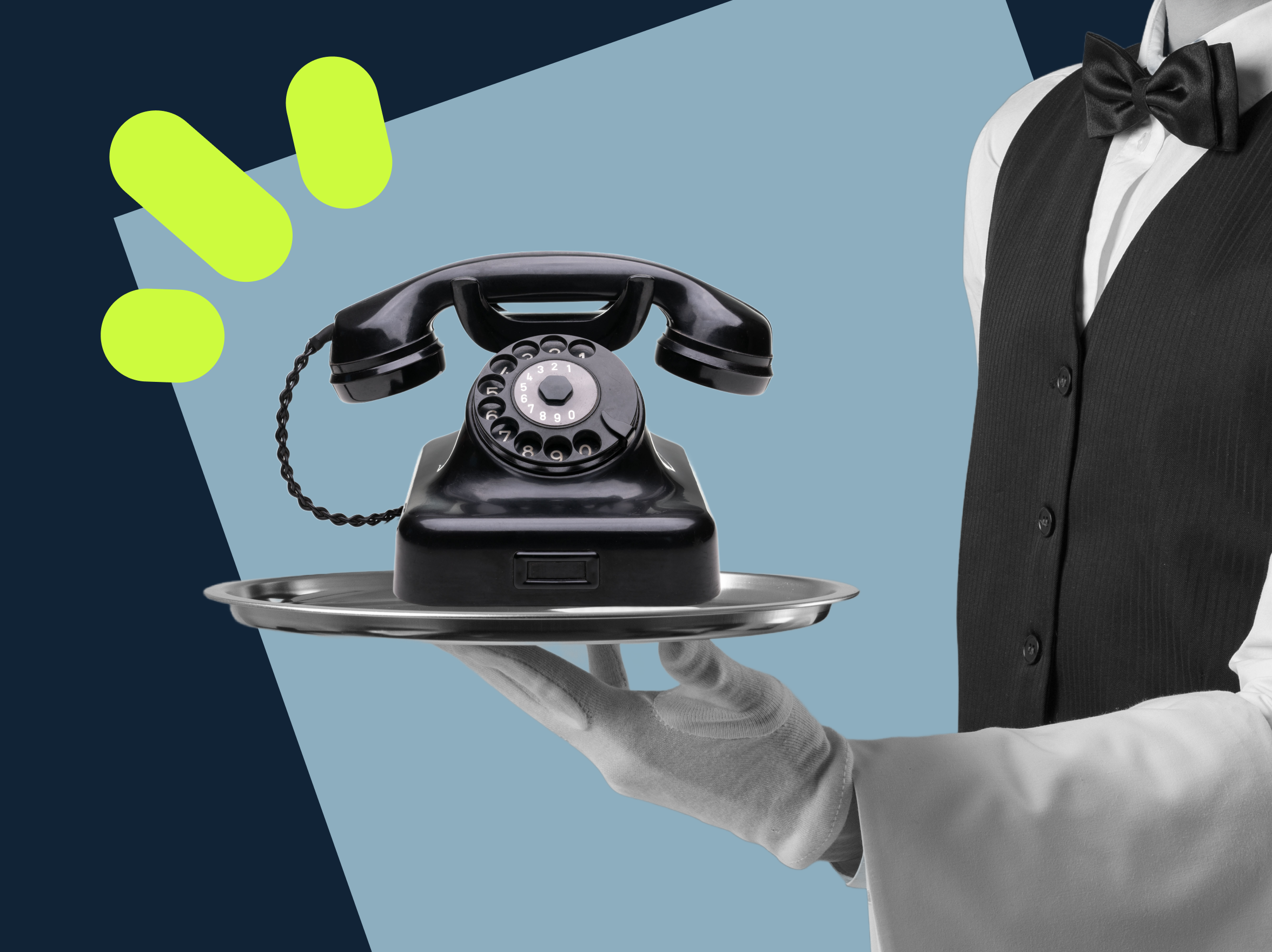Excellent telephone etiquette remains a vital skill for professionals across all industries. Even with the rise of emails, chats, and AI-powered bots, the telephone continues to be a primary channel for direct customer interaction. Customers value the human touch and personalized service that only a real conversation can provide.
Effective phone communication not only improves customer satisfaction but also strengthens your company’s reputation and bottom line. Mastering the skill of polite and empathetic conversation can make the difference between a happy customer and a lost one. This guide outlines phone etiquette basics, their importance, and tips for agent success.
What is phone etiquette?
Phone etiquette refers to the set of unwritten rules and guidelines for conducting oneself professionally and politely when communicating over the telephone. It encompasses everything from the tone of your voice and the words you choose to how you handle challenging situations. Good customer service phone etiquette ensures clear communication, minimizes misunderstandings, and leaves a positive impression on the person you’re speaking with.
Proper phone etiquette includes answering calls promptly, introducing yourself clearly, listening actively, speaking respectfully, and ending calls courteously. It also involves being mindful of cultural differences, handling sensitive information appropriately, and adapting to the specific needs of each caller.
The importance of phone etiquette & tone
Understanding and practicing proper phone etiquette is crucial for several reasons:
- Improves customer satisfaction: Polite and clear communication makes customers feel valued and heard, building trust and encouraging loyalty. When customers have positive experiences, they are more likely to continue doing business with you and recommend your company to others.
- Strengthens professional relationships: Good manners on the phone show professionalism and respect, setting the tone for productive interactions with colleagues, partners, and clients. This fosters a collaborative environment and can lead to more successful outcomes.
- Enhances company reputation: Companies that prioritize excellent phone etiquette stand out by offering a personal touch that technology alone can’t provide. A strong reputation for customer service can differentiate your business in a competitive market.
- Increases service speed: Effective communication reduces misunderstandings, saving time and resources for both parties involved. Clear instructions and information sharing lead to smoother processes and better results.
15 telephone etiquette tips for success
1. Personalize your greetings
Begin calls with a friendly greeting and introduce yourself. For example, say, “Good morning, this is Alex from ABC Company. How may I assist you today?” Personalizing your greeting sets a positive tone for the conversation and makes the caller feel welcome.
2. Craft professional and informative voicemails
Ensure your voicemail greeting is clear and professional. Include your name, department, and instructions for leaving a message. For example, “You’ve reached Sarah in the Marketing Department. I’m currently unavailable; please leave your name, number, and a brief message, and I’ll return your call as soon as possible.” This helps callers provide the necessary information, allowing you to return their call prepared.
3. Engage in active listening
Focus entirely on the caller by eliminating distractions. Listen carefully to their words, acknowledge their concerns, and ask clarifying questions when needed. Use verbal nods like “I see” or “I understand” to show engagement. This demonstrates genuine interest and leads to a more productive conversation.
4. Communicate with clarity and simplicity
Speak clearly and at a moderate pace to ensure the caller understands you. Use straightforward language and avoid technical jargon or slang that the caller may not be familiar with. Clear communication reduces misunderstandings and ensures that information is conveyed accurately.
5. Follow proper procedures when placing someone on hold
If you need to place a caller on hold, always ask for their permission first. Say, “May I place you on hold for a moment while I retrieve that information?” Explain why you will put them on hold and estimate how long it will take. Thank them for their patience when you return, acknowledging their time.
6. Be mindful of your tone and language
Maintain a friendly and professional tone throughout the call. Your tone of voice conveys emotion and can significantly impact how your message is received. Smiling while speaking can make you sound more approachable and positive. Avoid negative or harsh language that could offend or upset the caller.
7. Use the caller’s name to foster a connection
Address the caller by their name during the conversation. For example, “I understand your concern, Mr. Smith, and I’m here to help.” This personalizes the interaction and helps build rapport, showing that you care about them as an individual.
8. Manage calls wisely using technology
Utilize features such as call forwarding, conferencing, and automatic call distribution to handle calls smoothly. For instance, use conferencing to include additional team members who can assist the caller. These tools help ensure that calls are routed to the right person quickly, improving customer satisfaction and reducing wait times.
9. Respect privacy and handle information with care
Be cautious when discussing sensitive information over the phone. Ensure that you are in a private area where others cannot overhear the conversation. Adhere to company policies and legal regulations regarding confidentiality, such as GDPR or HIPAA compliance. This builds trust and protects both the customer and the company.
10. Provide clear follow-up actions
At the end of the call, summarize the key points discussed and outline any next steps. For example: “I’ll send the report by end of day, and we’ll schedule a follow-up call next Tuesday.” Confirm any agreements or actions that will be taken. This reassures the caller and sets expectations for future communication.
11. Avoid multitasking during calls
Give the caller your full attention by refraining from multitasking. Activities like typing unrelated emails, eating, or speaking with others can distract you and make the caller feel unimportant. Focus solely on the conversation to respond appropriately and provide better service.
12. Use appropriate call transfer etiquette
If you need to transfer the caller, explain the reason and ensure that the recipient is available. Say, “I believe our technical specialist can assist you better. May I transfer you to them?” Provide the caller with the name and extension of the person they are being transferred to. Stay on the line until the transfer is complete to ensure a smooth handoff.
13. Answer calls without delay
Aim to answer incoming calls within three rings whenever possible. Responding quickly shows professionalism and respect for the caller’s time. If you are unavailable, ensure that calls are redirected appropriately or that voicemail is available with a clear message.
14. Pay attention to cultural differences
Be aware of cultural nuances, especially when dealing with international callers. Understand proper forms of address, such as using titles and last names. Be mindful of suitable conversation topics and appropriate communication styles like directness or formality. This cultural sensitivity prevents misunderstandings and shows respect, enhancing the overall interaction.
15. Maintain a professional voicemail inbox
Regularly check and manage your voicemail messages. Respond to messages in a timely manner, ideally within one business day. Delete old messages to ensure your inbox isn’t full, which could prevent new messages from being recorded. Keeping your voicemail organized demonstrates reliability and attentiveness.
Additional notes for call center customer service
Empathize with the customer
Show understanding and concern for the customer’s situation. Use phrases like “I understand how frustrating that must be” or “I’m sorry to hear that you’re experiencing this issue.” This empathy can go a long way in building rapport and diffusing tension.
Stay calm under pressure
Remain composed, even if the caller is upset or angry. Keeping a steady tone helps de-escalate tense situations. Take deep breaths if needed and focus on finding a solution.
Additional tips for sales professionals
Build rapport quickly
Use open-ended questions to engage the caller and understand their needs. For example, “What challenges are you currently facing in your business?” This is one of the easy ways to encourage dialogue and help you adjust your approach.
Handle objections gracefully
Listen to concerns without interrupting and address them thoughtfully. Acknowledge the objection, provide relevant information, and reinforce the benefits. For instance, “I understand that budget is a concern. Let me explain how our solution can save you money in the long run.”
How great phone etiquette contributes to business success
Proper phone etiquette significantly impacts a company’s success:
- Improves customer experience: Positive interactions lead to higher satisfaction rates and increased loyalty. Satisfied customers are more likely to make repeat purchases and refer others to your business.
- Differentiates from competitors: Excellent phone manners offer a personal touch that sets a company apart. In a crowded marketplace, exceptional customer service can be a key differentiator.
- Strengthens reputation: Satisfied customers are more likely to recommend the business to others. Word-of-mouth referrals are powerful and can lead to increased market share.
- Enhances team morale: When employees communicate effectively and courteously, it fosters a positive work environment. This can lead to higher job satisfaction and reduced turnover.
Investing in a reliable phone system can enhance these benefits. Modern solutions offer features like caller ID, call recording, and voicemail management, enabling professionals to provide exceptional service. Advanced analytics can also provide insights into call volumes, customer preferences, and areas for improvement.
Practical examples of good phone etiquette
To illustrate how proper telephone etiquette can enhance professional interactions, let’s explore three real-life scenarios:
- Engaging in active listening
Scenario: During a call, a customer explains a complex issue with their account. Michael listens attentively without interrupting, takes notes, and waits until the customer finishes speaking. He then summarizes, “So, you’re experiencing difficulties accessing your account due to a password reset problem, correct?”
Outcome: The customer feels heard and understood. Michael’s active listening allows him to address the issue accurately and efficiently.
- Following proper hold procedures
Scenario: Tom needs to consult a colleague to answer a customer’s question. He says, “May I place you on hold for a moment while I gather that information?” After the customer agrees, Tom periodically checks back to provide updates.
Outcome: The customer feels respected and remains patient, knowing that Tom is actively working on their request. Proper hold etiquette prevents frustration.
- Personalizing greetings with caller ID
Scenario: Emma works in customer service and notices an incoming call from a repeat client, Mr. Thompson. Seeing his name on the caller ID, she answers, “Good afternoon, Mr. Thompson. This is Emma from XYZ Company. How may I assist you today?”
Outcome: By greeting him by name, Emma immediately creates a personal connection, making Mr. Thompson feel valued and recognized. This personalization sets a positive tone for the conversation. The company potentially obtained a loyal customer.
Common mistakes to avoid on the phone with customers
1. Interrupting the caller: Cutting off a customer while they are speaking can make them feel undervalued and frustrated.
Practice active listening and wait for natural pauses before responding. Allow the caller to express their thoughts fully.
2. Using jargon or technical terms: Employing industry-specific language can be considered bad phone etiquette. It can confuse customers who are not familiar with the terminology.
Use simple, clear language that is easy to understand. If technical terms are necessary, provide explanations.
3. Displaying impatience or rushing the caller: If you sound hurried or impatient, the customer may feel pressured or unwelcome. It’s the same as demonstrating annoyed body language in a face-to-face conversation.
Allocate sufficient time for each call and focus entirely on the current conversation. Maintain a calm and patient demeanor.
4. Neglecting to confirm understanding: Not verifying that both parties are on the same page can result in unresolved issues.
Summarize the customer’s concerns and confirm that you have understood them correctly. Ask questions like, “Did I capture everything accurately?”
5. Forgetting to use polite language: Omitting phrases like “please,” “thank you,” or “you’re welcome” can make interactions seem impersonal or rude.
Incorporate courteous expressions naturally throughout the conversation to convey respect and appreciation.
6. Allowing background noise or distractions: Taking calls on a speakerphone in noisy environments or allowing interruptions can make it difficult for the caller to hear you clearly.
Find a quiet space to take calls and minimize background noise. If taking calls in public, inform the people that you’re on an important call to avoid interruptions.
7. Speaking too softly or too loudly: Using an inappropriate volume can hinder communication.
Monitor your speaking volume to ensure it’s appropriate for the call. Adjust as needed based on the caller’s responses.
8. Neglecting to follow up as promised: Failing to follow through on commitments can damage credibility.
Keep a record of promises made during calls and set reminders to complete them. Consistent follow-up builds trust.
The history of business call etiquette
Understanding the evolution of phone etiquette highlights its enduring importance:
- Late 19th century: The invention of the telephone:
- Early 20th century: The role of telephone operators:
- Mid-20th century: Expansion and formal training:
- 1980s and 1990s: Technological advancements:
- 21st century: Modern communication technologies:
Alexander Graham Bell invented the telephone in 1876. Early users had to adapt to conversing without face-to-face visual cues, leading to the development of specific manners and protocols. Phrases like “Ahoy” or “Hello” became standard greetings.
Operators were trained to be polite and professional, setting standards for business call conduct. They used formal language and courteous phrases, emphasizing clarity and respect. Businesses began to recognize that telephone interactions reflected their company’s image.
Telephone usage surged as businesses expanded globally. Formal training programs were introduced, teaching employees to speak clearly, listen attentively, and address callers respectfully. The importance of telephone etiquette became ingrained in corporate culture.
The introduction of voicemail, caller ID, and automated systems added new dimensions to call etiquette. Professionals learned to leave concise and informative voicemail messages and use caller ID to personalize greetings. The rise of call centers led to standardized scripts and protocols.
Smartphones, VoIP, and virtual communication platforms further evolved call etiquette. Remote work increased reliance on telephone and virtual tools, emphasizing clarity, professionalism, and adaptability. Cultural sensitivity and time zone considerations became more prominent in global business.
Despite technological changes, the fundamental principles of respectful and clear communication remain essential. Understanding this history underscores the importance of maintaining high standards in telephone interactions.
Strengthen your professional communication
These tips strengthen customer interactions and help your organization’s reputation. Great phone manners not only enhance individual performance but also support business objectives by fostering customer loyalty and satisfaction.
Embrace these principles to make a meaningful impact in your professional journey. Continuous improvement in communication skills can lead to personal growth, better team dynamics, and increased opportunities.






























